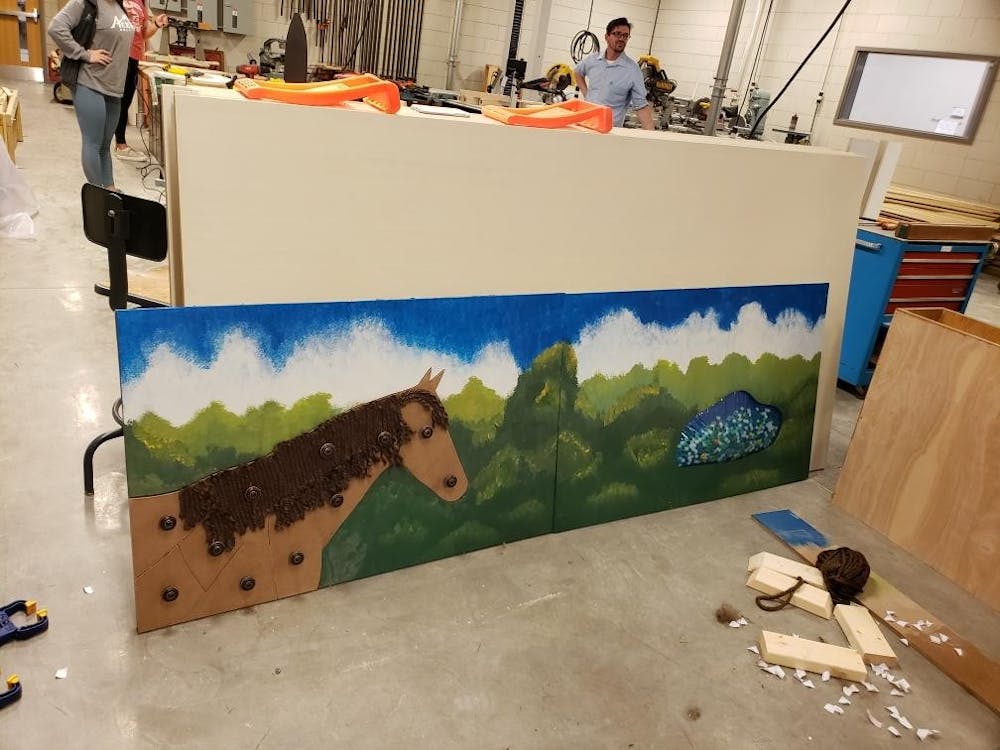Sensory issues:
Autism’s sensory issues can involve both hyper-sensitivities (over-responsiveness) and hypo-sensitivities (under-responsiveness) to a wide range of stimuli.
These can involve:
- Sights
- Sounds
- Smells
- Tastes
- Touch
- Balance
- Body awareness (proprioception)
Source: Autism Speaks
“Purples, greens and yellows.”
These colors calm children and help them better understand and think through ideas. This is something Emily Schripsema, senior interior design major, learned during her immersive learning class focused on children with autism.
As part of Ball State’s Health and Environmental Design Research Lab, the project was funded by a $20,000 Provost Immersive Grant. The class also partnered with Children’s TheraPlay, a nonprofit pediatric clinic in Carmel, Indiana, which serves children with special needs through physical and occupational therapy.
The first phase of the project challenged students to design a plan for a new construction project at the clinic. Last semester, students helped design and build customized furniture focused on the five senses and how kids with autism can benefit from those designs.
Throughout the semester, Schripsema said, she worked on a cruising wall with knobs that assisted children learning to stand up and walk and a sensory wall, which featured LED lights that created a puzzle.
“We can design anything we want, but we actually had to figure out how it was put together — joints, and screws, and lengths and widths,” she said. “It brought a whole new dimension and reality to our project.”
The class, led by Shireen Kanakri, associate professor of interior design, began in fall 2018. This partnership with the clinic is important, she said, because there is a gap in interior designing to produce designs that benefit children with autism.
“I decided to share it with our students to get [a] variety of design solutions that might help the kids with autism,” Kanakri said in an email.
Megan Draper, senior interior design major, also worked on building the living wall — a wall with plants and a self-contained irrigation system. A trough at the top of the wall helps children water the plants and learn how to take care of them.
Apart from experiencing nature indoors, Draper said children can experience sensory inclusion by touching and watering the plants.
“It’s really opened my eyes to just the impact that interior design can have on people and their living environment,” she said.

Students in the interior designing immersive learning class designed this cruising wall. Children can hold on to the cruising wall for support to stand up and walk. Emily Schripsema, Photo Provided
All of the new equipment built by students was completely funded by Ball State, which Kathy Pelletier, executive director of the clinic, said was “invaluable to the clinic because it operates on a lean budget.
Another benefit from the partnership is students can customize the pieces for the clinic’s environment, specifically for the needs requested by therapists, Pelletier said.
“That’s something that probably under ordinary circumstances would be cost prohibitive to us to just get a customized piece of furniture in our facility,” she said.
With all the design plans and blueprints ready, Pelletier said the new construction project at the clinic is scheduled to begin in April.
“It’s so great for us to be involved in something that’s really impacting students at Ball State,” she said. “It’s a great partnership which is mutually beneficial for us and the students at Ball State.”
Kanakri said students benefited from the project by dealing with a real client, having a real site to work on and being able to test their designs with real people.
Draper, who will be working for a custom residential interior design company after graduation, said she didn’t have an appreciation for the different things that are included with interior design when she first joined the program.
“I guess as I’ve gone through school I’ve learned more of the importance of designing for specific needs in populations,” she said. “I wouldn’t have considered how big of a need it was to design for children with disabilities and just that little things like that can really have a big impact on their lives.”
Schripsema, who wants to get into pediatric health care design, said the project gave her an opportunity to learn about how children with disabilities experience the world.
“Having the chance to do something in that field, specifically involving children with disabilities and specialities — it was something I wouldn’t have gotten if I didn’t do the project.”
Contact Rohith Rao with comments at rprao@bsu.edu or on Twitter @RaoReports.





